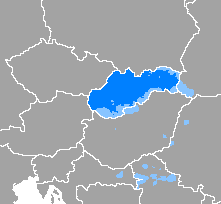
Pan-Slavism, a movement which crystallized in the mid-19th century, is the political ideology concerned with the advancement of integrity and unity for the Slavic people. Its main impact occurred in the Balkans, where non-Slavic empires had ruled the South Slavs for centuries. These were mainly the Byzantine Empire, Austria-Hungary, the Ottoman Empire, and Venice.

The Slavic languages, also known as the Slavonic languages, are Indo-European languages spoken primarily by the Slavic peoples and their descendants. They are thought to descend from a proto-language called Proto-Slavic, spoken during the Early Middle Ages, which in turn is thought to have descended from the earlier Proto-Balto-Slavic language, linking the Slavic languages to the Baltic languages in a Balto-Slavic group within the Indo-European family.

Slovak is a West Slavic language of the Czech–Slovak group, written in Latin script. It is part of the Indo-European language family, and is one of the Slavic languages, which are part of the larger Balto-Slavic branch. Spoken by approximately 5 million people as a native language, primarily ethnic Slovaks, it serves as the official language of Slovakia and one of the 24 official languages of the European Union.
Slavic or Slavonicstudies, also known as Slavistics, is the academic field of area studies concerned with Slavic areas, languages, literature, history, and culture. Originally, a Slavist or Slavicist was primarily a linguist or philologist researching Slavistics. Increasingly, historians, social scientists, and other humanists who study Slavic area cultures and societies have been included in this rubric.

The West Slavic languages are a subdivision of the Slavic language group. They include Polish, Czech, Slovak, Kashubian, Upper Sorbian and Lower Sorbian. The languages have traditionally been spoken across a mostly continuous region encompassing the Czech Republic, Slovakia, Poland, the westernmost regions of Ukraine and Belarus, and a bit of eastern Lithuania. In addition, there are several language islands such as the Sorbian areas in Lusatia in Germany, and Slovak areas in Hungary and elsewhere.

Zlín Region is an administrative unit of the Czech Republic, located in the south-eastern part of the historical region of Moravia. It is named after its capital Zlín. Together with the Olomouc Region it forms a cohesion area of Central Moravia. It is located in the eastern part of the Czech Republic, where the borders with Slovakia are formed by its eastern edge. It borders the South Moravian Region in the southwest, the Olomouc Region in the northwest and the Moravian-Silesian Region in the north. Culturally, the region is composed of parts of three traditional Moravian regions: Haná, the Moravian Slovakia and the Moravian Wallachia, as the city of Zlín lies roughly at their tripoint.

Uherské Hradiště is a town in the Zlín Region of the Czech Republic. It has about 25,000 inhabitants. The agglomeration with the two neighbouring towns of Staré Město and Kunovice has over 37,000 inhabitants.

Mnichovo Hradiště is a town in Mladá Boleslav District in the Central Bohemian Region of the Czech Republic. It has about 8,900 inhabitants. The historic town centre is well preserved and is protected by law as an urban monument zone.
A gord is a medieval Slavonic fortified settlement, usually built on strategic sites such as hilltops, riverbanks, lake islets or peninsulas between the 6th and 12th centuries in Central and Eastern Europe. The typical gord usually consisted of a group of wooden houses surrounded by a wall made of earth and wood, and a palisade running along the top of the bulwark.
Rada is the term for "parliament" or "assembly" or some other "council" in several Slavic languages. Normally it is translated as "council". Sometimes it corresponds to "parliament", or in Soviet Union contexts, to "soviet". It also carries a meaning of advice, as in the English word "counsel".
The term North Slavic languages is used in three main senses:

Roztoky is a town in Prague-West District in the Central Bohemian Region of the Czech Republic. It has about 9,000 inhabitants.
The 1995–96 Czech First League was the third season of top-tier football in the Czech Republic.
Grodziszcze may refer to:

The Czech–Slovak languages are a subgroup within the West Slavic languages comprising the Czech and Slovak languages.
Kushnir is a Ukrainian and Jewish surname, meaning furrier.

Choustníkovo Hradiště is a market town in Trutnov District in the Hradec Králové Region of the Czech Republic. It has about 600 inhabitants.

The Church of Jesus Christ of Latter-day Saints in the Czech Republic refers to the Church of Jesus Christ of Latter-day Saints and its members in the Czech Republic. At year-end 1989, there were less than 100 members in the Czech Republic. In 2022, there were 2,643 members in 12 congregations.







